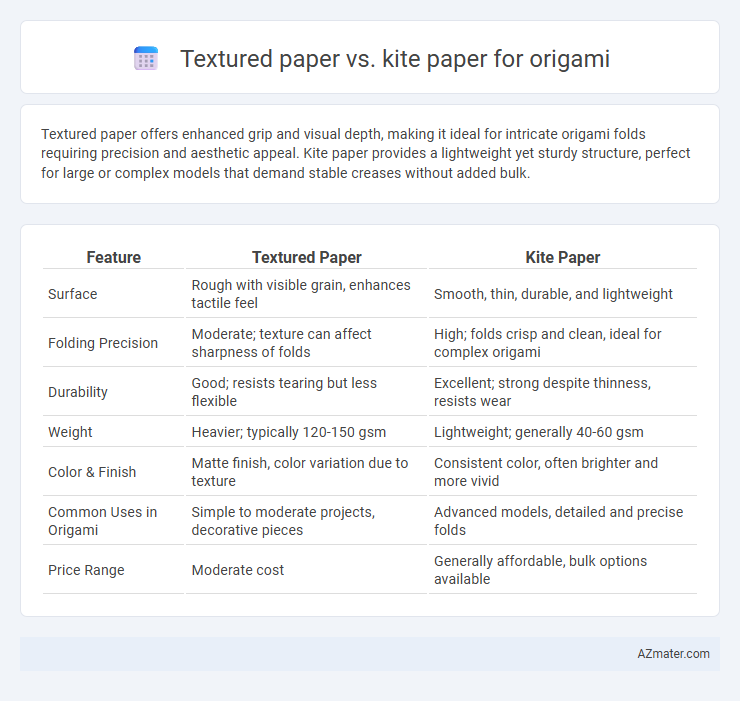Textured paper offers enhanced grip and visual depth, making it ideal for intricate origami folds requiring precision and aesthetic appeal. Kite paper provides a lightweight yet sturdy structure, perfect for large or complex models that demand stable creases without added bulk.
Table of Comparison
| Feature | Textured Paper | Kite Paper |
|---|---|---|
| Surface | Rough with visible grain, enhances tactile feel | Smooth, thin, durable, and lightweight |
| Folding Precision | Moderate; texture can affect sharpness of folds | High; folds crisp and clean, ideal for complex origami |
| Durability | Good; resists tearing but less flexible | Excellent; strong despite thinness, resists wear |
| Weight | Heavier; typically 120-150 gsm | Lightweight; generally 40-60 gsm |
| Color & Finish | Matte finish, color variation due to texture | Consistent color, often brighter and more vivid |
| Common Uses in Origami | Simple to moderate projects, decorative pieces | Advanced models, detailed and precise folds |
| Price Range | Moderate cost | Generally affordable, bulk options available |
Introduction to Origami Paper Types
Textured paper features a tactile surface that enhances the visual and sensory experience of origami, making it ideal for projects requiring added depth and detail. Kite paper, traditionally lightweight and durable, offers smoothness and strength, suitable for precise folds and complex designs. Understanding these paper types helps origami artists select materials that optimize both aesthetics and folding performance.
What is Textured Paper?
Textured paper for origami features a distinct surface pattern or grain that enhances grip and visual appeal, making intricate folds more defined and tactile. Unlike smooth kite paper, textured paper often uses fibers or embossing techniques to create a raised or rough finish, providing origami artists with increased control and aesthetic variety. This paper type is ideal for models requiring precision and durability while adding a unique tactile dimension to the finished piece.
What is Kite Paper?
Kite paper is a lightweight, durable paper traditionally used in kite making, characterized by its smooth texture and resistance to tearing, making it ideal for origami requiring precise folds and sharp creases. Compared to textured paper, which often has a rough or embossed surface adding visual interest but potentially hindering crisp folding, kite paper offers superior flexibility and structural integrity. Its balance of thinness and strength enhances the creation of intricate origami models while maintaining stability and detail.
Key Differences Between Textured and Kite Paper
Textured paper features a rough surface that enhances grip and adds visual interest, making it ideal for complex origami designs requiring precise folds. Kite paper is typically lightweight, smooth, and tear-resistant, allowing for easy folding and crisp edges, especially suited for large or intricate models. The key differences lie in their surface finish, durability, and folding behavior, with textured paper offering tactile variation and kite paper providing strength and flexibility.
Texture and Feel: Impact on Folding Techniques
Textured paper offers a tactile surface that enhances grip, making complex folds and precise creases easier to achieve in origami, while kite paper's smooth finish allows for more fluid, graceful folds but may slip during intricate steps. The pronounced grain and roughness of textured paper often provide better structural integrity to sharp creases, improving the model's overall definition. In contrast, kite paper, made from strong yet silky fibers, is ideal for delicate, flowing designs that require subtle manipulation and less resistance during the folding process.
Color Vibrancy and Transparency
Textured paper often enhances color vibrancy in origami by creating subtle light diffusion that deepens hues, while kite paper tends to be more translucent, allowing light to pass through and soften the colors. The semi-transparent nature of kite paper can produce delicate gradient effects, ideal for layered designs or intricate folds. Choosing between the two depends on whether a bold, opaque finish or a lighter, airy appearance is desired for the origami project.
Durability and Tear Resistance
Textured paper offers enhanced durability due to its fibrous surface, which provides resistance to tearing during intricate origami folds. Kite paper, traditionally made from strong mulberry fibers, is lightweight yet boasts exceptional tear resistance, making it ideal for complex models requiring multiple folds. While both materials excel in durability, textured paper generally withstands repeated handling better, whereas kite paper combines lightness with superior tear strength.
Suitability for Different Origami Models
Textured paper offers enhanced grip and structural integrity, making it ideal for complex origami models with intricate folds like modular designs or 3D sculptures. Kite paper, characterized by its lightweight and smooth surface, excels in simpler or traditional origami shapes where precision and crisp creases are essential. Selecting paper depends on the model's complexity and desired texture, with textured paper preferred for durability and kite paper favored for delicate, detailed creations.
Cost and Availability Comparison
Textured paper often costs more than kite paper due to higher manufacturing complexity and premium materials, making it less budget-friendly for frequent origami practice. Kite paper is widely available in craft stores and online marketplaces at affordable prices, ideal for beginners and bulk folding projects. The greater availability and lower price point of kite paper make it a practical choice for origami enthusiasts prioritizing cost-effectiveness.
Which Paper is Best for Your Origami Projects?
Textured paper offers enhanced grip and visual interest, making it ideal for complex origami models requiring precision and aesthetic appeal. Kite paper, known for its smooth surface and lightweight durability, excels in crisp folds and is perfect for beginner to intermediate projects. Choosing the best paper depends on the intricacy of your design and the desired final appearance; textured paper suits detailed, decorative pieces, while kite paper provides reliability in structural folds.

Infographic: Textured paper vs Kite paper for Origami
 azmater.com
azmater.com